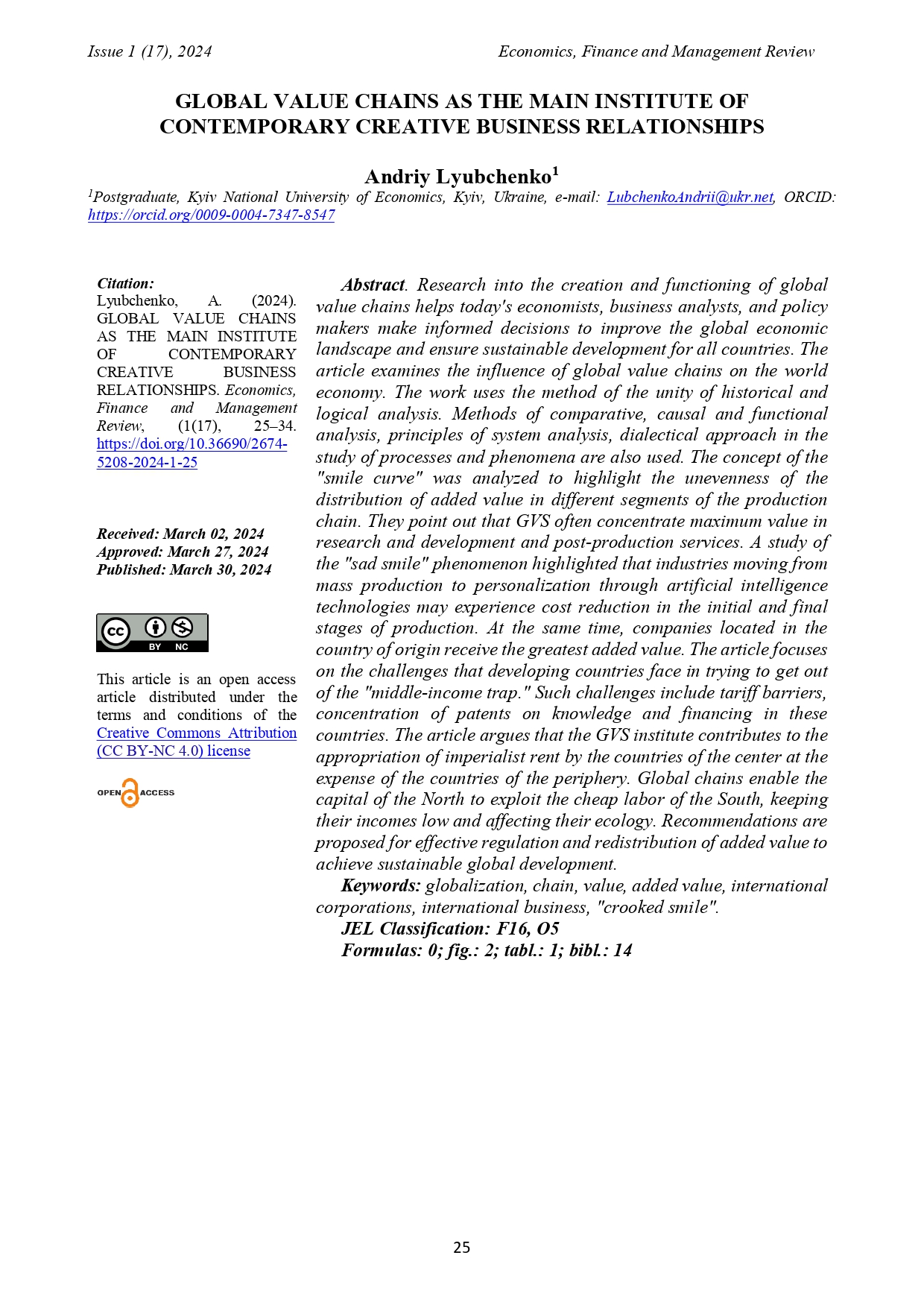GLOBAL VALUE CHAINS AS THE MAIN INSTITUTE OF CONTEMPORARY CREATIVE BUSINESS RELATIONSHIPS
DOI:
https://doi.org/10.36690/2674-5208-2024-1-25Keywords:
globalization, chain, value, added value, international corporations, international business, crooked smileAbstract
Research into the creation and functioning of global value chains helps today's economists, business analysts, and policy makers make informed decisions to improve the global economic landscape and ensure sustainable development for all countries. The article examines the influence of global value chains on the world economy. The work uses the method of the unity of historical and logical analysis. Methods of comparative, causal and functional analysis, principles of system analysis, dialectical approach in the study of processes and phenomena are also used. The concept of the "smile curve" was analyzed to highlight the unevenness of the distribution of added value in different segments of the production chain. They point out that GVS often concentrate maximum value in research and development and post-production services. A study of the "sad smile" phenomenon highlighted that industries moving from mass production to personalization through artificial intelligence technologies may experience cost reduction in the initial and final stages of production. At the same time, companies located in the country of origin receive the greatest added value. The article focuses on the challenges that developing countries face in trying to get out of the "middle-income trap." Such challenges include tariff barriers, concentration of patents on knowledge and financing in these countries. The article argues that the GVS institute contributes to the appropriation of imperialist rent by the countries of the center at the expense of the countries of the periphery. Global chains enable the capital of the North to exploit the cheap labor of the South, keeping their incomes low and affecting their ecology. Recommendations are proposed for effective regulation and redistribution of added value to achieve sustainable global development.
Downloads
References
Alcacer J., Oxley J. (2014) Learning by supplying. Strategic Management Journal. № 35 (2).
Antrаs Р. (2020) Conceptual aspects of global value chains. The World Bank Economic Review. № 3. 551-574.
Baldwin R., Venables A. (2013) Spiders and Snakes: Offshoring and Agglomeration in the Global Economy. Journal of International Economics. Vol. 90. № 2. 245-254/
Crook, T., Combs J. (2017) Sources and consequences of bargaining power in supply chains. Journal of Operations Management. № 25(2). 546-555. doi:10.1016/j.jom.2006.05.008
Dindial M. (2020) Between a rock and a hard place: A critique of economic upgrading in global value chains. Global Strategy Journal. DOI: 10.1002/gsj.1382
Gereffi G. (1994) The Organization of Buyer-Driven Global Commodity Chains: How US Retailers Shape Overseas Production Networks in Commodity Chains and Global Capitalism. Westport : Praeger.
Gereffi G. (2005) The Governance of Global Value Chains. Review of International Political Economy. № 12(1). 78-104.
Global financial development report 2014: Financial inclusion. World Bank Publications, 2015.
Milberg W., Winkler D. (2011) Economic and social upgrading in global production networks: Problems of theory and measurement. International Labour 141 Review. № 150 (3-4). 341-365. DOI: 10.1111/j.1564-913x.2011.00120.x
Mudambi R. (2008) Location, Control and Innovation in Knowledge-Intensive Industries. Journal of Economic Geography. № 8(5). 699-725.
Porter M.E. (1985) Competitive Advantage, Creating and Sustaining Superior Performance. New York: Free Press.
Wade R.H. (2018) The Development State: Dead or Alive? Development and Change. № 49(2). 518-546.
Wal-Mart Will Punish Its Suppliers for Delivering Early. Bloomberg : 2017. Retrieved from: https://www.bloomberg.com/news/articles/2017-07-12/fined-forarriving-early-wal-martputs-its-suppliers-on-notice
Walmart: What Happened In India? 2013. Retrieved from: https://t1p.de/swhgr

Downloads
Published
How to Cite
Issue
Section
License

This work is licensed under a Creative Commons Attribution-NonCommercial 4.0 International License.








